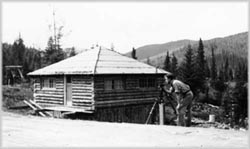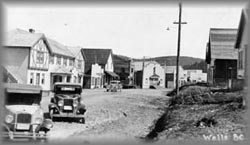 |
|
|

Many British Columbian towns started as mining settlements in the early twentieth century. In the early 1920s, there was nothing at the future site of Wells except a sawmill and a roadhouse that had been there since the 1890s. The mining town of Wells, British Columbia, was planned, built, and maintained by the Cariboo Gold Quartz Mining Company. The company formed a wholly owned subsidiary called The Wells Townsite Company Limited, incorporated in 1933 to purchase, develop, and sell land for Wells.
The directors were made up of Dr. Burnett, Mr. Solibakke, and Mr. Wells - The Three Musketeers - who owned one share each with the balance of 25,000 shares held by the Cariboo Gold Quartz Mining Company.
The goal of the Townsite Company was to house the flood of miners and their families pouring into the area. Gold rush towns earlier had sprung up without any structure, with shacks put up without any organization, as was the case with Barkerville. The placer miners only wanted to rush in, make their money, and leave as quickly as possible. They would exhaust the creek beds of gold and depart to other prospects, abandoning their temporary homes. A company town was desireable for Wells with long term goals for a permanent townsite; hence, it was not unusual for a company to be involved in the building and development of a town to attract a stable labour supply to isolated regions. The company was more than willing to provide the funds since long term profits from gold mining were expected for the town.
The only other place in British Columbia not depressed at this time was Bridge River, another company town and the locale of Pioneer Mine. However, Wells was not as interested in profits from the town as was the case in Bridge River, and Wells encouraged private commercial enteprise and individual growth within its community. Opportunity was there for the taking - a refuge when gold mining was one of the only prosperous industries in British Columbia.
The objective of the townsite was providing water and electrical services, a structured town with streets and sidewalks, telephones, and encouraging commercial enterprise. Fred Wells further explains the townsite's objective
"A town is essential in a neighbourhood where there are 200 men on payroll including Island Mountain Company and ourselves. At present, there are a great many shacks and cabins being built in the woods and along the roadside. It is much better to provide a proper place for people to live and this is what we plan to do." 4
Dr. Burnett, one of the townsite's directors, spoke to shareholders about their preference for married men as employees as they were more stable and had responsibilities to provide for their families. Therefore, they needed proper housing to attract more families to this remote region - a modern, happy little town.
Company Towns | Features of a Town | Home | Meet the Team | Site Map
Last updated: June 8, 2000


